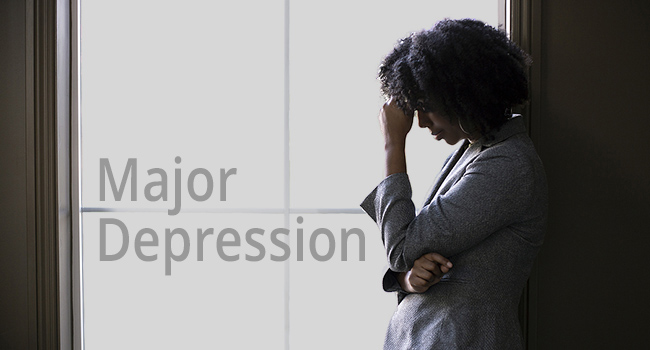
It is normal to feel sad once in a while, but if you are sad most of the time and it is affecting your day-to-day life you may have major depression. Major depressive disorder (MDD) is a psychological disorder characterized by pervasive low mood for at least 2 weeks. It is also known as clinical depression.
It is a common psychiatric disorder with the lifetime prevalence of the disease being about 12%. Clinical depression is twice as more prevalent in women than men.
How Major Depression is different from Depression?
Depression is a state of low mood when you lack motivation or are too tired to do anything. You lack interest in things you previously enjoyed. It is a normal temporary reaction to life events such as a broken marriage or loss of a loved one. It may cause you to lose appetite, sleep and you may experience an inability to concentrate on things. This state of mood lasts for a few days to a week following the incident.
However, in a major depressive disorder, the changes last a long time. The feature of depression is a symptom of MDD. To diagnose you with major depression, suggestive features limiting the quality of life should last for more than 2 weeks. The clinical features of Major depression are discussed below.
Risk Factors
There is no one cause of depression, its etiology is thought to be multifactorial and involves various hereditary, biological, environmental, and psychological factors. Factors related to you may also contribute to an increased risk of depression- It can be caused as a result of fluctuation in levels of your brain chemicals called neurotransmitters. Levels of serotonin, norepinephrine and were indicated earlier to be key determinants in the development of MDD. Newer studies have found the role of other inhibitory and excitatory neurotransmitters in causing MDD.
- Positive family history of depression has been shown to increase susceptibility.
- Severe stress and abuse during early life have shown to result in major alterations in behavior patterns leading to change in your brain structure and function. These people are more predisposed to developing MDD later in life.
- Personality traits and life events play a determining role in the development of MDD.
- Alcohol and drug abuse have also been shown to lead to the development of MDD.
Clinical Features of Major Depression
Symptoms are different in different people, common symptoms include:- Fatigue and loss of energy throughout the day
- Loss of appetite and sexual drive
- Decreased or excess sleep
- Significant unintentional weight loss or gain
- Feeling helpless and hopeless almost every day
- Loss of interest in day to day activities and activities once enjoyed
- Recurring thoughts of harming or killing oneself, or regular attempts at suicide
- Marked restlessness
- Delusion or hallucinations maybe sometimes present
Your doctor may diagnose you with major depression if these symptoms are persistently present for at least two weeks, unlike mild depression where these symptoms may be present but not for extended periods.
Diagnosis
The diagnosis of MDD is made based on your medical history and mental state examination. The medical history should invariably include family history, socio-economic history, and history of substance abuse. History from a family member or a friend should also be taken. Neurological tests should be done to rule out any underlying disease leading to major depression.The diagnostic and Statistical Manual of Mental Disorders (DSM) has laid down symptom criteria to diagnose MDD. According to the criteria:
- There must be a change in your previous functioning.
- The symptoms must be present for at least 2 weeks
- At least one symptom should be either persistent low mood or loss of interest in activities once found pleasurable.
You must also experience 5 or more of the symptoms mentioned in the above section should be present for at least 2 weeks.
Management
The treatment of clinical depression is individualized depending upon the severity, etiology, presence of co-existing medical conditions, and your preference.Various methods of management are available including drug therapy, psychotherapy, Electroconvulsive therapy, or light therapy. Multiple methods may be combined for the best results.
- Drugs: Antidepressants are the initial choice of drugs for MDD of all severity. The most common group of drugs being SSRIs. These drugs prevent the breakdown of serotonin, increasing its level in the brain, and improving the condition.
- Psychotherapy: Psychotherapy involves consulting with your psychotherapist regularly to improve self-esteem, learn to adjust to stressful situations, improve communication skills, and achieve a sense of satisfaction. It has shown to be very helpful when used in combination with drug therapy in the treatment of MDD.
- ECT: Electroconvulsive therapy (ECT) is indicated in severe cases of clinical depression. The therapy helps improve brain activity bypassing a controlled stream of current into your brain.
- Treating other medical conditions associated with MDD may help treat some cases.
Treatment Modalities Currently Undergoing Clinical Trials
Effectiveness of SSRI: A study is being conducted to predict the success of SSRI in the treatment of major depression. Various data are collected from people with major depression under SSRI treatment and patients will be categorized based on their responses to therapy. This also helps in personalizing the therapy according to patient response.Transcranial Direct Current Stimulation (tDCS): The effectiveness of tDCS in treating cases of major depression is also under study. It has been shown to improve symptoms of MDD when applied to prefrontal areas of the brain but the results obtained are variable. The study aims at understanding the mechanism of action of tDCS and its proper optimization for use as an effective antidepressant.
Combining Ketamine with Buprenorphine: A study to explore the benefits of intravenous ketamine followed by buprenorphine (an opioid drug) in sustained anti- suicidal effects in patients with major depression is being conducted and it is in the third stage of its clinical trial.
